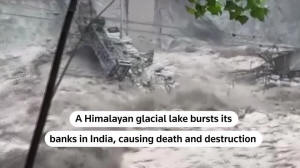Himalayan lake flooding kills 14, more than 100 missing in India
 Send a link to a friend
Send a link to a friend
 [October 05, 2023]
By Subrata Nag Choudhury and Jatindra Dash [October 05, 2023]
By Subrata Nag Choudhury and Jatindra Dash
NEW DELHI/KOLKATA (Reuters) -At least 14 people were killed and 102 were
missing on Thursday after heavy rains caused a Himalayan glacial lake in
northeast India to burst its banks, the worst such disaster in the
region in more than five decades.
The Lhonak Lake in Sikkim state burst its banks on Wednesday causing
major flooding, which authorities said had impacted the lives of 22,000
people. It is the latest deadly weather event in South Asia's mountains
being blamed on climate change.
The weather department said Sikkim received 101 mm (4 inches) of rain in
the first five days of October, more than double normal levels,
triggering floods worse than one in October 1968 in which an estimated
1,000 people were killed.
The department has predicted heavy rain over the next three days in
parts of Sikkim and neighboring states.
The latest flooding was exacerbated by water released from state-run
NHPC's Teesta V dam, local officials said. Four of the dam's gates had
been washed away and it was not clear why they had not been opened in
time, a government source told Reuters.

As of early Thursday, the state disaster management agency said 26
people had been injured and 102 were missing, 22 of whom were army
personnel. Eleven bridges had been washed away, hampering rescue
operations which were already affected by heavy rainfall.
Authorities in neighboring Bangladesh were on alert with a state-run
water development board official warning that five districts in the
northern part of the country could be inundated with a rise in the level
of the Teesta river, which enters Bangladesh downstream of Sikkim.
"Continued efforts are on to dig out vehicles submerged under the slush
at Burdang near Singtam. The search for the missing persons is now
focusing in the areas downstream of Teesta river," an Indian defense
spokesperson said.
FUEL SCARCE, FOOD AVAILABLE
Video footage from the ANI news agency, in which Reuters has a minority
stake, showed flood waters surging into built-up areas where several
houses collapsed. Army bases and other facilities were damaged and
vehicles submerged.
Satellite imagery showed that nearly two-third of the lake seems to have
been drained.
[to top of second column]
|

At least 14 people were killed and 102 are missing after heavy rains
caused a Himalayan glacial lake in northeast India to burst its
banks, and rescuers were being hampered by washed out bridges and
fast flowing rivers, said officials on Thursday (October 5).

Sikkim, a small state of about 650,000 people which is wedged in the
mountains between Nepal, Bhutan and China, was cut off from Siliguri
in the neighbouring state of West Bengal as the main highway had
collapsed.
State lawmaker G.T. Dhungel told Reuters that petrol and diesel had
become scarce in state capital Gangtok but food was readily
available.
A cloudburst on Wednesday dropped a huge amount of rain over a short
period on the Lhonak Lake, about 150 km (90 miles) north of Gangtok
near the border with China, triggering flash floods down the Teesta
valley.
A 2020 report by India's National Disaster Management Agency said
glacial lakes are growing and pose a potentially large risk to
downstream infrastructure and life as glaciers in the Himalayas are
melting due to climate change.
"Sadly, this is the latest in a series of deadly flash floods that
ricocheted across the Hindu Kush-Himalayan region this monsoon,
bringing the reality of this region's extreme vulnerability to
climate change all too vividly alive," said Pema Gyamtsho,
director-general of the Nepal-based International Centre for
Integrated Mountain Development.
Other mountainous areas of India, as well as parts of neighboring
Pakistan and Nepal, have been hit by torrential rains, flooding and
landslides in recent months, killing scores of people.
A report by India's National Remote Sensing Centre scientists a
decade ago had warned the chances of the lake bursting its banks was
"very high" at 42%.

(Reporting by Subrata Nag Choudhury in Kolkata, Jatindra Dash in
Bhubaneswar, Tanvi Mehta, and Krishn Kaushik in New Delhi,
additional reporting by and Sarita Chaganti Singh, Ruma Paul and
Rajendra Jadhav; editing by Robert Birsel, Michael Perry, YP Rajesh
and Kim Coghill)
[© 2023 Thomson Reuters. All rights
reserved.]This material
may not be published, broadcast, rewritten or redistributed.
Thompson Reuters is solely responsible for this content. |